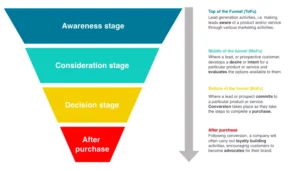Today’s brands are constantly vying for our attention. From the clothes we wear to the food we eat, the digital services that keep us entertained, and the tech that keeps us connected: marketing is ubiquitous.
With marketing messages so commonplace, it’s easy to shrug them off as inconsequential. However, when executed well, a sophisticated marketing campaign can get through to us almost subconsciously. An effective campaign will always be underpinned by tried and tested techniques, and one of these is the marketing funnel.
But what exactly is the marketing funnel, and how does it work? In this post, we’ll explore the concept and offer some beginner tips for creating a marketing funnel for your campaigns. We’ll keep it relatively light, answering the following questions:
- What is the marketing funnel?
- How does each stage of the marketing funnel work?
- How do you create a marketing funnel?
- Summary
Ready to get all the fundamental facts about the marketing funnel? Then let’s get started.
1. What is the marketing funnel?
The marketing funnel is a visual representation of the process that converts leads (or potential customers) into buyers (or paying customers). It’s commonly referred to as the purchase funnel or the conversion funnel.
While the marketing funnel might sound like a bit of a gimmick, it’s actually a well-established model. While there are many variations on the theme, all modern marketing funnels are based on a tried and tested approach, first proposed in 1898 by influential American advertising guru, Elias St. Elmo Lewis.
Before going further, let’s take a look at his idea.
A brief history of the marketing funnel
Towards the end of the 19th century, modern product marketing started to emerge. The field, however, was still in its infancy, and marketing professionals were still developing its core principles. One of these professionals was Elias St. Elmo Lewis, a plucky young advertising advocate who, in 1898, was the first person to map the customer journey that marketing professionals essentially use to this day.
Lewis’ model is known as ‘the AIDA model’, a step-by-step acronym that stands for:
- Awareness—a customer’s passive awareness of a particular product.
- Interest—a customer’s active interest in that product.
- Desire—a customer’s desire for a particular product from their preferred company or brand.
- Action—the steps a customer takes towards purchasing that preferred product from a given provider.
While the AIDA model is quite simplistic by today’s standards, it remains the basis of all modern marketing funnels. Over the 20th century, as marketing techniques grew more varied and sophisticated and as potential customers found new ways to engage with brands, advertisers incorporated additional steps into the AIDA model. And with that, the concept of the modern marketing funnel was born.
Modern marketing funnels
Today, there is no clear consensus on what a modern marketing funnel should look like. This might seem confusing, but it reflects the diversity of the world in which we operate and the wide range of products and services available.
Rather than taking a ‘one size fits all’ approach, modern marketing funnels usually incorporate additional steps, reflecting the varied ways in which customers engage with brands, industries, products, and services. Nevertheless, modern marketing funnels are still based on the original AIDA model.
Here, it makes sense to answer a fundamental question: Why a marketing funnel? Why not a cylinder or a square? Put simply, not all leads (or potential customers) are converted into paying customers. Some may be aware of a product yet choose not to buy it, and so the funnel narrows as potential customers are lost along the way.
Next up, let’s dive in and look at the different parts of the traditional marketing funnel.
2. How does each stage of the marketing funnel work?
Despite some variability, we can divide all marketing funnels into four main stages. Warning: There’s some jargon approaching, but we’ll talk you through it!
Here are the four broad categories of any good marketing funnel:
- Top of the funnel (ToFu): The top of the marketing funnel (or ToFu, for short) explores the awareness stage of the sales process, i.e. where leads become aware of a product or service. In itself, this may be broken into numerous additional steps.
- Middle of the funnel (MoFu): The middle of the marketing funnel (MoFu) focuses on the aspect of the sales process where potential customers progress from awareness of a product to considering which different products or brands might interest them personally.
- Bottom of the funnel (BoFu): The bottom of the marketing funnel (BoFu) looks at a potential customer’s final decision-making process, i.e. which product (or service), if any, they want to buy.
- After purchase: While this is not included in every marketing funnel, many funnels also include a fourth, post-purchase category. This focuses on a customer’s behavior after carrying out a purchase.
Within these four categories, individual steps may vary slightly. You’ll often find that each funnel will go into more (or less) detail, depending on who has devised the funnel and for what purpose. For instance, a funnel designed to look primarily at post-purchase behavior (to inform future advertising campaigns) will likely have more steps in this section.
Here are the common stages you will find in most modern marketing funnels:

ToFu—Awareness stage
Awareness (or ‘discovery’)—where a lead becomes aware of a product or service’s existence.
MoFu—Consideration stage
Desire—where a customer’s desire to own a particular product grows.
Intent—where customers develop an intention (or need) for a product.
Evaluation—where customers actively compare products to find the one that best suits their needs.
BoFu—Decision stage
Commitment—where customers commit to a particular product.
Conversion—where customers take actions that lead from consideration to active pursuit of their chosen product or brand.
Purchase/transaction—the exchange of money for a product or service. This is the final goal of many marketing funnels.
After purchase stage
Loyalty—As customers develop loyalty, they will return to a brand for their future needs.
Advocacy—customers may share testimonials or recommendations to new potential customers.
In traditional marketing funnels, each stage of the process is largely brand-driven, i.e. it drives customers towards a decision that will ultimately benefit the company by creating revenue.
Modern brands commonly use marketing funnels to inform their content strategies. For instance, the awareness stage may involve developing some splashy advertising or email campaigns, while the consideration stage is likely to focus on things like instructional blogs or product pages that inform potential customers about their offering.
The main takeaway is that each step in the marketing funnel is linear, and is accompanied by different marketing activities.
3. How do you create a marketing funnel?
Now we know what a marketing funnel is and how it is used, how would you create one for your product, service, or brand? Here are a few things to think about:
What is your goal?
The ultimate purpose of any marketing funnel is to develop campaigns and content that nudge customers towards a particular action. First and foremost, then, you should consider what this action is. For instance, do you want people to purchase a given product or service? If so, which one? And are you targeting new leads? Or are you trying to develop repeat business?
Answering questions like these will give you a better idea of which step in the funnel to start with. For instance, if you have a solid customer base, try focusing on the post-purchase stage to build loyalty and repeat business. Meanwhile, if you’ve yet to make any profit, you’ll probably want to start with the awareness stage and work your way down.
What channels and resources are available to you?
Each step in the marketing funnel is accompanied by many possible approaches. Large corporations with limitless budgets may be able to target all channels, but for most marketing teams, this usually isn’t feasible. Presuming you have limited resources, be selective about which channels and techniques to focus on. When your resources are tight the answer is simple: go where your target audience is!
This will involve researching the platforms that your key demographic uses and their preferred communication style. Millennials, for example, may respond well to a combined email and Instagram campaign, whereas an offline mailshot or telemarketing approach might work better if you’re targeting those in their sixties or seventies. Most importantly, ensure your chosen content strategy aligns with your capacity. It’s great to be ambitious, but it’s also a good idea to start small and build as you go.
Select a couple of approaches
Once you’ve narrowed down which step of the funnel to start with, and which channels would work best, you’ll need to select some content approaches. Depending on the stage of the funnel, this might include a mix of online and offline activities like direct mail and email, search engine optimization, press/public relations, advertising campaigns, events, trials, demos, and free resources or giveaways.
Rather than stretch yourself too thin, try to select one or two of these approaches at first. Aim to get them working smoothly and double up on content wherever you can. This won’t just save time but you’re more likely to succeed by targeting a smaller cohort with highly customized content. Once you’ve got that working, you can expand.
Develop compelling content
After mapping the ideal customer journey from awareness to purchase, it’s time to develop your content. Once again, the best approach is to be selective. As we touched on, highly relevant content that targets a select cohort of leads is likely to be more effective than a scattergun approach. For example, you might want to focus on writing product pages for your website and creating instructional blogs to improve organic search rankings. Once that’s established, then perhaps you’ll be ready to branch into paid search.
The main thing is to ensure that your different approaches feed into one another properly… if you’re sending an email campaign to raise awareness, for example, make sure this links to an appropriate web page so that customers can enter the consideration phase.
4. Summary
In this post, we’ve offered a high-level overview of the traditional marketing funnel, its origins, and how it’s commonly used in business. We’ve learned that:
- The marketing funnel is a visual representation of the process that turns potential customers into paying customers.
- The original marketing funnel (the ‘AIDA model’: standing for awareness, intent, desire, and action) was developed by Elias St. Elmo Lewis in 1898.
- Modern marketing funnels are built on the original AIDA model, usually with additional steps to reflect the complexities of the 21st-century customer journey.
- Modern marketing funnels can be divided into four broad stages: Top of the funnel (ToFu) or ‘awareness stage’; middle of the funnel (MoFu) or ‘consideration stage’; bottom of the funnel (BoFu) or ‘decision stage’; and the after purchase stage, dealing with things like loyalty and advocacy.
- When creating a marketing funnel, start by considering your goals, the channels your target audience uses, and the resources you have available to you.
- Once you’ve established which channels to target, focus on creating a limited amount of high-precision but interconnected content that will drive your audience from the awareness stage to the purchase stage, and beyond.
Want to learn about digital marketing? Then check out this free, 5-day Intro to Digital Marketing short course. You can also read the following introductory guides:
- Common Digital Marketer Job Descriptions and What They Mean
- The Best Digital Marketing Examples To Inspire You
- How To Become a Marketing Associate
